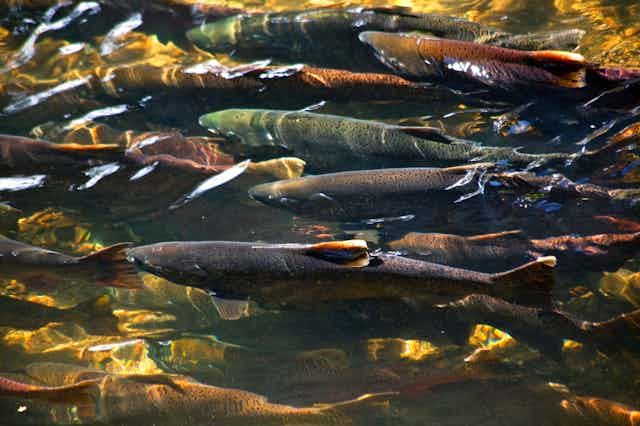Greater London is crisscrossed by 14,800km of public roads, each with an average width of 8m. This network accounts for 8% of the metropolitan area, and motorways and A-roads alone cross the Thames and its tributaries at least 400 times. A similar picture is seen in cities across the world.
You’ve heard of, and maybe seen, hedgehogs and deer meeting sticky ends while trying to traverse the tarmac labyrinth. But fish need to cross roads too. Where roads cross small rivers – and they do, hidden underfoot, a lot more than you realise – you get structures like culverts. These are tunnels installed under roads and rail lines which are supposed to help the rivers flowing underneath stay connected.
But culverts, like dams and weirs, can limit the movement of water, nutrients and species in the rivers they conceal. Globally, the numbers of monitored migratory fish species have declined by an average of 76% since 1970. Culverts have contributed to this by disrupting the access of these species to food and spawning areas. Poorly installed, ageing, damaged, and “perched” culverts that form mini waterfalls on the downstream side of the structure modify water flows and prevent fishes from migrating up and downstream.

But this is not the only effect that roads have on rivers. Roads carrying high volumes of traffic are also sources of toxic chemicals, which can run off tarmac and into nearby streams. Combined, culverts and chemicals create unhealthy environments that migratory fishes cannot avoid.
Read more: Culverts – the major threat to fish you've probably never heard of
That’s not a roundabout, it’s a trap
Like London, many of the world’s largest cities are nestled at river mouths – the first ports of call for migratory fishes. In the UK, Atlantic salmon return to rivers from the sea to spawn as adults, while European eels return to the same waters to feed as they grow from juveniles to adults. So salmon and eels both need to make it upstream and back again to the sea, navigating these large cities with their heavily trafficked roads to complete their lifecycles.
In the US city of Seattle in the 1990s, the habitats of some urban rivers were restored and culverts that had acted as barriers to migratory fish were removed. Despite this positive change, it was subsequently found that within these rivers, up to 90% of Coho salmon migrating upstream to spawn would suddenly die after rainstorms. Scientists determined that the deaths were related to the density of roads and high traffic volumes, but it wasn’t enough to pinpoint the exact cause.
It wasn’t until 2020, more than two decades later, that scientists discovered Coho salmon were dying en masse from exposure to a toxic chemical called 6PPD-quinone, which leaches from tyre particles that wash into streams. The researchers believe this compound is probably found on busy roads globally.
A similar study from 2019 mapped the roads which contribute the most runoff pollution to rivers across Greater London, using the number and types of vehicles that travel on a given road each day and monthly rainfall figures. The hotspots of pollution the researchers were able to map corresponded with river catchments already classified as “poor” or “bad” by a recent EU Water Framework Directive assessment.

Avoiding the traps
Around the world, more roads and higher traffic volumes lower the water quality of urban rivers, increasing deaths among migratory fish species.
Modifying or replacing culverts that limit fish movements will only be part of the solution if the toxic chemicals that run off tarmac and into rivers aren’t also addressed. In pollution hotspots, this will mean capturing and filtering stormwater before it enters rivers.
While much of the concern about cars has focused on air pollution and climate change, it’s increasingly clear that shifting to battery-powered alternatives alone won’t reverse the impacts that roads and driving have on rivers and the wider environment.

